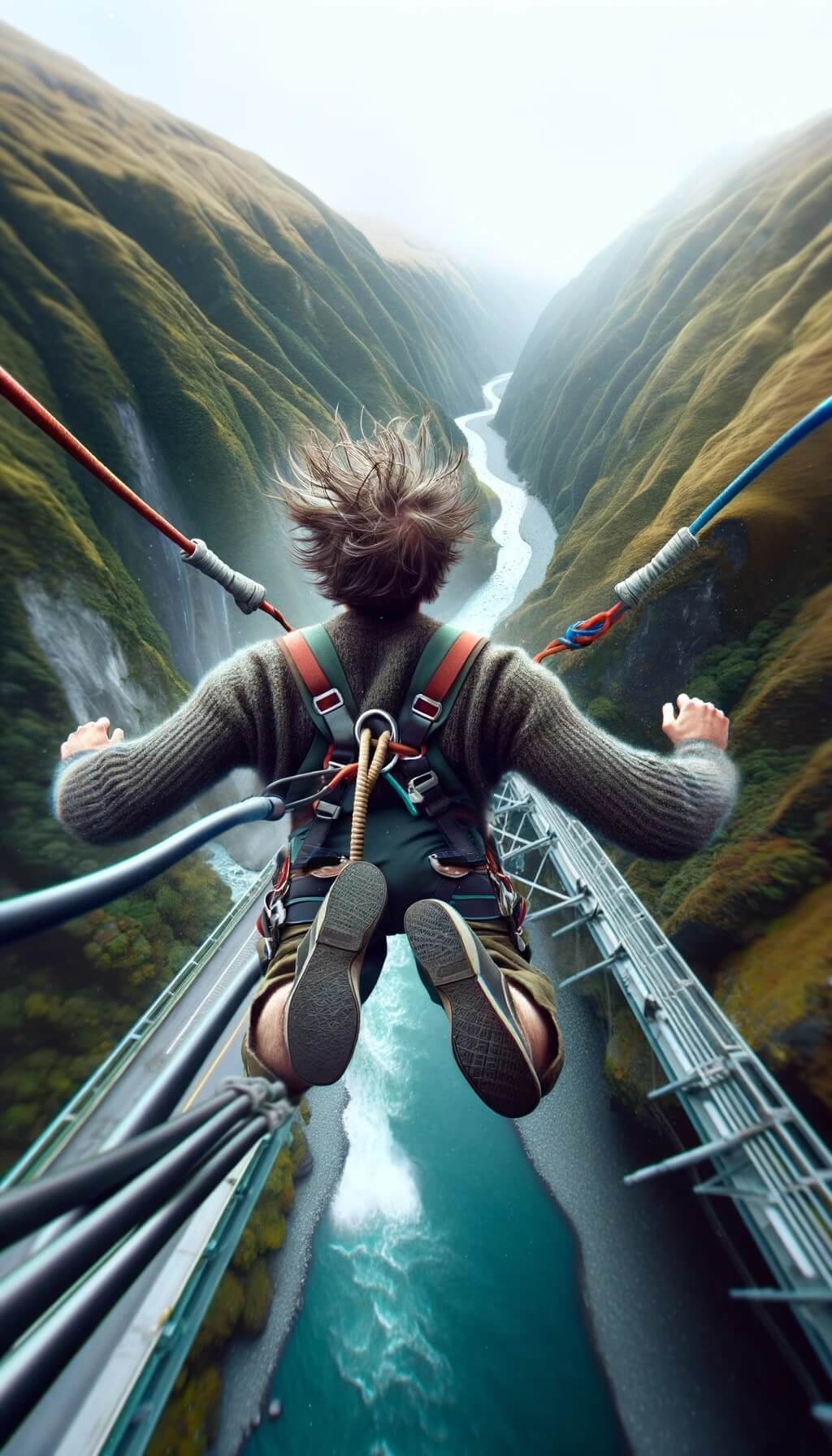
Many say bungee jumping is the closest thing people will get to human flight. As travelers continue to prioritize adventure in their trips, this extreme sport’s popularity shows no signs of slowing down.
Bungee jumping originated on the island of Vanuatu where men jumped from wooden platforms with vines tied to their ankles as a rite of passage.
Then, in 1988, A.J. Hackett opened the world’s first commercial bungee jumping site on the Kawarau Gorge Suspension Bridge in Queenstown, New Zealand.
Fast-forward to today and bungee jumping has become one of the most popular adventure sports in the world.
Adrenaline junkies can now jump off a dam in Switzerland, skyscraping towers in China, or from the mighty Victoria Falls Bridge in Africa.
For marketing directors and tour operators steering successful bungee jumping operations, staying up to date with the latest statistics will help you better plan your strategies moving forward.
In this article, we dive into the key bungee jumping statistics shaping the industry landscape.
Bungee Jumping Industry Overview
- Two of the world’s highest bungee jumps can be found in China: The Macau Tower, where jumpers fly off a tower 764 feet above the ground, and the Zhangjiajie Grand Canyon Glass Bridge in the Hunan province, with a height of 850 feet.
- South African Mohr Keet, who completed a jump at the age of 96 in 2010, holds the record for the oldest bungee jumper in the world.
- In 2023, New Zealander Mike Heard reclaimed the world record for the most bungee jumps in a single day when he jumped off an Auckland bridge 941 times.
How many bungee jumping businesses are there in 2023?
It’s difficult to estimate the number of bungee jumping operators in the U.S., but we can get a good idea about where the industry is headed by looking at the bungee jumping equipment market.
The bungee jumping equipment market is expected to reach a value of well over $83.6 million by 2027, which represents a compound annual growth rate (CAGR) of 10%.
Bungee cords, harnesses, safety helmets, shock absorbers, and landing mats are a few of the essential pieces to create a safe and exciting jump experience. The more people engage in bungee jumping, the higher the demand becomes for these products. The growth in the equipment market reflects the adventurous activity’s growing popularity.
The U.S. and Canada are estimated to contribute around 35% to the growth of the global market over the next five years.
Is bungee jumping a growing trend or just a fad?
Adventure travelers were allured by new, off-the-beaten-path experiences in 2023. In fact, the year prior, the need for “an adrenaline rush” or “a trip that provides a challenging element” was among the top 10 motivations for travel for the first time. For those who crave that adrenaline kick, bungee jumping is the perfect fit.
Aside from the growth in the bungee jumping equipment market, we can also see the activity’s popularity among adventure enthusiasts who continue to chase after world records.
New Zealander Mike Heard, for instance, made it a point to reclaim his world record for the most bungee jumps in a single day just last year.
Meanwhile, one of the tallest bungee jumps in the world — the Zhangjiajie Grand Canyon Glass Bridge in China — recently opened at the end of 2020. Even then, with pandemic restrictions curbing travel activities worldwide, operator Jonni Deaker said his business was averaging 20 jumps a day at the moment, a pretty good number for a jump that size.
Bungee jumpers will have a hard time getting bored with the wide variety of jumping sites around the world. Meanwhile, your business can reap the benefits from growing interest among adrenaline junkies close to home.
Where is bungee jumping most popular?
A list of the top bungee jumping sites around the world will include spots like:
- Auckland Harbour Bridge, New Zealand
- Europabrücke Bridge, Austria
- Great Canadian Bungee, Ontario
- Macau Tower, China
- Victoria Falls Bridge, Zimbabwe
- Verzasca Dam, Switzerland
Meanwhile, in the U.S., the most well-known sites are The Navajo Bridge in Arizona,; The Royal Gorge Bridge in Colorado, and The Rio Grande Bridge in New Mexico.
What do you need to do before starting a bungee jumping business
Starting a bungee jumping operation requires a high upfront investment, with startup costs ranging from $10,000 to $50,000.
Operators need to raise enough capital to purchase the right equipment, lease or purchase land, and build a secure jumping platform. Then there are the typical costs that every adventure tourism business must cover, like instructor training, permitting and licensing, and marketing investments. Liability insurance can run from $5,000 to $15,000.
Before starting an operation, business owners will also want to understand the demand for bungee jumping in their target area. Once they’ve locked down a site and equipment, they’ll need to ensure that everything meets safety standards and undergoes regular inspections.
Given the nature of the activity, it is also necessary to implement digital waivers, like Xola Waivers, to protect your company from potential lawsuits, as well as establish a solid emergency response plan.
How many injuries occur at bungee jumping places?
Bungee jumping is an extreme adventure activity. The combination of free falling and the extreme force of the cord tugging jumpers back toward the sky can cause varying degrees of injuries to guests’ eyes, spine, and neck.
However, accidents that do occur are usually tied to faulty equipment, poorly trained operators, or getting weight calculations wrong. This underscores the importance of regular equipment inspections and highly trained staff.
How many people die from bungee jumping accidents?
There were 18 recorded deaths from bungee jumping between 1986 and 2002. In more recent years, there have been 5 bungee jumping fatalities recorded between 2015 and 2018. Bungee jumping death statistics report a 1 in 500,000 chance of a fatality.
Which is more dangerous: bungee jumping or skydiving?
Both skydiving and bungee jumping are extreme sports that may appear dangerous to the untrained jumper. However, they share a similar safety record, with very few deaths per year. The odds of a fatality in skydiving is 1 in 500,000 jumps in the past decade, the same as with bungee jumping.
How to keep guests safe
Safety is the most important aspect of any bungee jumping operation. Safety helmets, training gear, and inspection need to undergo rigorous testing, be inspected regularly, and adhere to local, national, and international safety regulations.
Moreover, operators should keep the following considerations in mind to keep guests safe:
- Hire trained and certified staff who are experienced in bungee jumping operations, including jumpmasters, riggers, and support personnel.
- Invest in high-quality bungee cords, harnesses, and other safety equipment.
- Regularly inspect and maintain all equipment to ensure it meets safety standards.
- Provide guests with a comprehensive safety briefing before each jump, making them aware of all the procedures, risks, and safety protocols involved.
- Screen participants for health conditions that may pose a risk during a jump.
- Establish weight and age limits for participants to ensure that the equipment is used within its designed parameters.
- Have the right comprehensive liability insurance coverage in place to protect both the business and its guests in the event of accidents or injuries.
- Conduct regular training sessions for staff to keep them updated on safety protocols, emergency response procedures, and any advancements in safety standards.
- Monitor weather conditions closely. Strong winds or storms can pose significant risks to jumpers, making it crucial to have a system in place to suspend operations when needed.
What to do if someone gets injured in your business
Even with all of the right precautions, bungee jumping injuries can still happen. If someone gets injured, your staff should be well-trained in your emergency response protocols.
- Provide first aid assistance and assess the injury.
- Seek immediate medical attention for the injured guest, if necessary.
- Collect witness statements and create an incident report.
- Contact your insurance provider.
How to avoid being sued if someone gets injured
- Solid safety guidelines will help avoid injuries and protect your bungee jumping business from getting sued.
- Mandatory safety waivers that outline the risks and rights being waived when a customer agrees to jump are also key in shielding your business from litigation. (Pro Tip: Xola offers a free, built-in digital waiver solution, allowing all guests, not just the person booking for the group, to complete this online right after they book.
- Invest in the right insurance provider, who will help you navigate any lawsuits that arise. Consider that every state has a statute of limitations on personal injury claims. In most cases, it’s two years from when the injury occurred, but the number of years that victims have to file varies.
***
Allow these statistics to serve as a compass guiding you to an exciting new phase in your business, where you welcome just as many experienced jumpers as new ones — and continuously set yourself apart through excellent service and an impeccable safety record.




